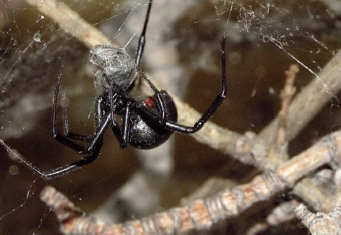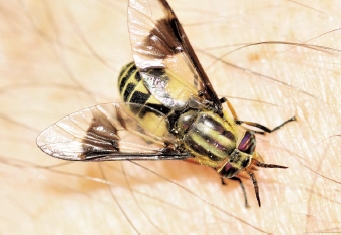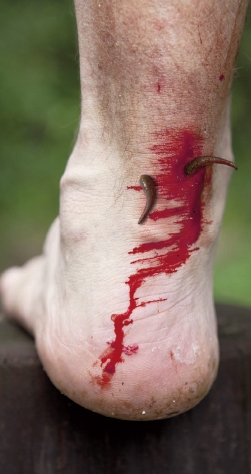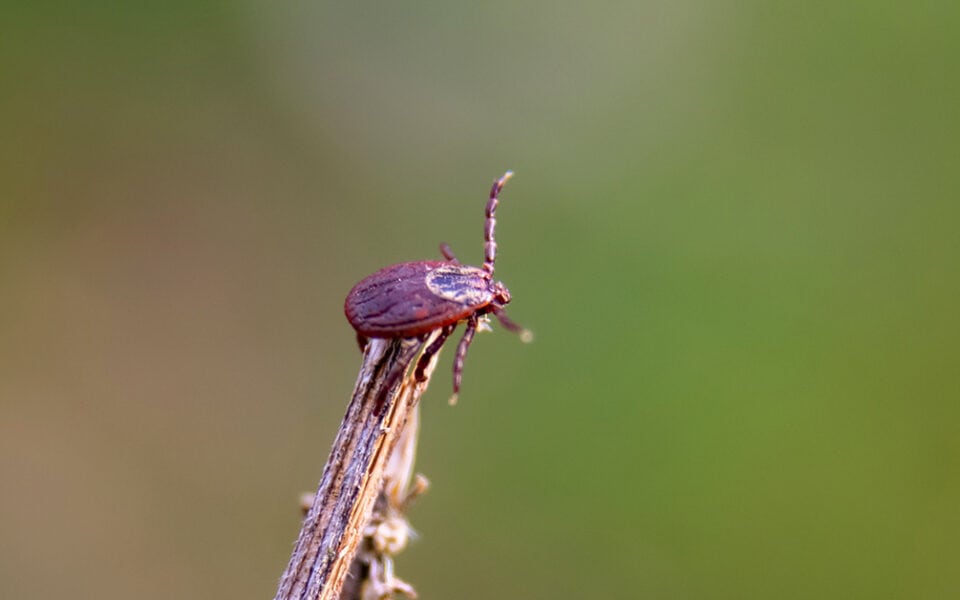Here is a list of my 12 least-favorite pests to avoid while hunting. Get to know them better and you too can be better prepared in the great outdoors.
Ticks and spiders are my top two picks from the arachnid group of joint-legged invertebrate animals called arthropods…also known as “creepy crawlies.” Read on to find out which one is more likely to cause you trouble. The answer might surprise you.
Ticks
Ticks seem to be everywhere when I go hunting. I encounter them in the woods, bushes, high grasses and leaf debris. They need heat and moisture to survive and can sense heat and carbon dioxide from a nearby host animal. There are 80 species of ticks in the United States, but only about a dozen are considered a health threat to humans.
The ticks I encounter the most are the deer tick and the wood tick. The deer tick is the only one of the two that can transmit Lyme disease. The wood tick can transfer Rocky Mountain spotted fever in some areas of North America and is the most commonly found tick in the United States. These ticks hatch from eggs in spring and become nymphs during their first year of life.
Blacklegged ticks (commonly called deer ticks) are the only ticks that carry Lyme disease. And not all of these ticks carry the disease. The tick larva are the most likely to transfer Lyme disease during the late spring and summer if they become infected with the disease from host animals (commonly mice) once they start consuming blood. The young deer ticks are so small they are hard to detect when they attach themselves to your body. An infected deer tick must bite you for at least 24 hours to pass on Lyme disease.
Several other tick-borne diseases to be aware of in addition to Lyme disease include: Anaplasmosis, Babesiosis, Borrelia miyamotoi, Colorado Tick Fever, Ehrlichiosis, Heartland virus, Powassan disease, Rocky Mountain spotted fever (RMSF), STARI and Tularemia. These diseases are regionally based so are not all present across the entire United States. The types of ticks that spread diseases are: American dog tick, deer tick, brown dog tick, Gulf Coast tick, Lone Star tick, Rocky Mountain wood tick, and Western blacklegged tick.
According to the Centers for Disease Control, the Lone Star tick is primarily found in the southeastern and eastern United States. White-tailed deer are a major host of Lone Star ticks. These ticks are identified by a white spot in the middle of their backs.
Ticks are spreading across the United States. The CDC has a lot of great information at: http://www.cdc.gov/ticks, including maps and printouts to help hunters.
The best ways to avoid ticks are:
- Wear protective clothing with long sleeves shirts tucked in to your pants.
- Tuck the ends of your pants into your socks or boots to help keep them from getting underneath your clothing.
- Use Permethrin spray on your clothing.
- Keep dirty hunting clothes in your laundry room or stored away.
- Take a shower when you come indoors.
To learn even more on the dreaded tick listen the episode 47 of the GameKeeper Podcast “Ticks Ticks Ticks”, where we dive deep into the world of ticks and learn more than we probably wanted to know.
Chiggers
Chiggers are found in high grass, embankments near water sources, berry thickets and in wooded areas underneath trees. They are most active when it is warm outside on summer and fall afternoons. Chiggers become inactive when the temperature falls below 60 degrees Fahrenheit.
When the temperature falls below 42 degrees Fahrenheit, chiggers will die.
They often bite ankles, legs, knees and around the crotch area. While the bites of these tiny arachnids are itchy, they do not give humans diseases.
Spiders
 According to insectidentification.org, it is believed that some three-quarters of the human population are intimidated by spiders in one form or another. In reality, while the black widow, hobo and brown recluse spiders are venomous and should be avoided, most spiders will not hurt you, in fact, they actually help to reduce other insect species.
According to insectidentification.org, it is believed that some three-quarters of the human population are intimidated by spiders in one form or another. In reality, while the black widow, hobo and brown recluse spiders are venomous and should be avoided, most spiders will not hurt you, in fact, they actually help to reduce other insect species.
The black widow spider lives across North America but is the most prevalent is the southern and western United States. They are usually found in wood-piles and other areas where debris has built up. They may live in outhouses where flies are plentiful. The female spider is black with red on its abdomen. Only the female spider is venomous and is twice as large as the male.
The hobo spider lives in the Pacific Northwest. It is large and brown with yellow markings on its abdomen. Hobo spiders do not have dark bands on their legs. Hobo spiders may be found in retaining walls and stacks of firewood.
The brown recluse, also known as the “violin spider,” is most prevalent in the South and Midwest. It is brown in color with dark violin-shaped mark on its head and has six equal-sized eyes. Brown recluse spiders are usually found underneath logs, or in piles of rocks or leaves. The spider cannot bite humans without counter pressure that traps the spider against the skin.
Most spiders encountered in the outdoors are not aggressive and are actually beneficial. Be mindful when setting up in area with understory debris and rotting wood to clear out an area to sit down. Wear gloves and long sleeves when moving debris.
Flying Pests
 Flies have two wings, instead of four. The fewer number of wings does not seem to stop the following four creepy crawlies from driving me nuts. Flies are able to locate humans by sensing carbon dioxide and moisture in exhaled breath, dark colors and movement, warmth and perspiration.
Flies have two wings, instead of four. The fewer number of wings does not seem to stop the following four creepy crawlies from driving me nuts. Flies are able to locate humans by sensing carbon dioxide and moisture in exhaled breath, dark colors and movement, warmth and perspiration.
A fly’s mouth is made to pierce and then suck. I have had way too many experiences of piercing and sucking flies hounding me when I am trying to hunt off the ground. This happens to me most often when I hunt down by the creek.
Deer Flies
Deer flies bite into the skin, causing blood flow which the flies “lap up.” Unfortunately for hunters, adult deer flies are frequently encountered near water elements like streams, lakes, ponds and swamps right where we need to be able to hunt. They also like moist areas where leaves, old wet hay and other such debris stands where we need to set up to hunt. They are most active during the spring.
Deer flies are about the size of a house fly. They are typically yellow-brown to black with dark bands on their wings. They may have iridescent green eyes and do have painful bites. One deer fly species in the United States can transmit tularemia like a tick.
Gnats
Measuring about 1/8” in length, gnats are much smaller than a house fly. Gnats love to swarm around the heads of hunters on warm days. They seem to especially enjoy crawling up under a facemask and biting around the eyes.
Tuck your facemask into your shirt and cover your ears with a hat. That’s about all you can do. Like other flies they are attracted to moist environments.
Horse Flies
If I could have but one word to describe a horsefly, it would be “persistent.” A second word would be “painful.” There is nothing that feels worse than trying to walk to your stand while being stalked by this biting fly with its scissor-like mouthparts. People have been known to have allergic reactions to their potent bites. They seem to be very attracted to sweat and are most active in summer and early fall.
The horse fly is large and is a fast flier and like other flies is attracted to sweat, dark colors, carbon dioxide and movement.
Mosquitoes
Mosquitoes lay their eggs in stagnant water such as ponds, marshes, swamps and other wetland habitats. That is why their presence is as prevalent in those areas as adults. They prefer hot, humid environments so they are most active during the summer months. Female mosquitoes need proteins from blood to mature their eggs. Humans make great hosts to obtain blood from. Unfortunately, this causes some problems to us humans.
Here in North America we don’t worry about Malaria, but we do have to be concerned about another illness: West Nile virus. The virus cycles back and forth between mosquitos and infected birds. The birds give it to the mosquitoes, and in turn, bite us and transmit the West Nile virus to humans. People are not capable of giving it back to other mosquitoes because it is not strong enough in our system to retransmit. Many people who are infected show no symptoms.
The male mosquitoes form large swarms at dusk and the females join them to reproduce. That is why they seem most prevalent at dusk. Mosquitoes prefer type O blood, heavy breathers, and people with a lot of body heat. Females are attracted to carbon dioxide. When possible, wear long sleeves, long pants, and socks when outdoors.
Fleas
Fleas are insects that have no wings that bite people then suck blood. The cat flea is known as the most common. Cat fleas may attack a wide variety of warm-blooded animals including dogs, humans, chickens, rabbits, squirrels, rats and mice. They like shaded areas and hot, humid summer months promote egg-laying activity.
The greatest adult flea populations are produced in August to September and most bites occur on the lower legs and ankles. Fleas can be drowned. You are most likely to encounter fleas when you are cleaning a rabbit or a squirrel or your hunting dog may pick them up.
Hornets & Wasps
 Bald-faced hornets make their large nests in trees and in meadows and forest edges. The nests can hold up to 700 hornets. Typically, the larger the nest the fiercer the hornets will defend it. Only mated females overwinter by burrowing into trees. Make sure you look over your favorite tree for these before you hang a treestand during the summer.
Bald-faced hornets make their large nests in trees and in meadows and forest edges. The nests can hold up to 700 hornets. Typically, the larger the nest the fiercer the hornets will defend it. Only mated females overwinter by burrowing into trees. Make sure you look over your favorite tree for these before you hang a treestand during the summer.
Of course, there are myriad types of wasps and bees that can be pests, especially to hunters. In fact, there are hundreds of different species of wasps that inhabit the United States. Unlike a bee, whose stinger generally falls out after a single sting, a wasp can sting multiple times, though only female wasps sting, while male wasps bite.
Ones to look out for are yellow jackets, which can number 5,000 in a single colony; and paper wasps. A single paper wasp nest usually only harbors 50 to 100 wasps, but they can be extremely aggressive if bothered.
Fire Ants
Reddish-brown-colored fire ants live in mounds. They will attack anything that disturbs their mound. They sting by grasping skin with their jaws and then injecting venom. The male drone ants do not have wings, but the queen and the swarmer ants do. The ants are usually active from spring time through fall.
Fire ants eat animal meats, greasy and sweet materials. They prefer to have their large, sandy mounds in sunny fields. Nests may also be built in places including the underside of logs and rocks. According to the National Park Service, “Areas infested with single queen colonies contain 40-150 mounds per acre (rarely more than 7 million ants per acre.) In areas with multiple queen colonies, there may be 200 or more mounds and up to 40 million red fire ants per acre.”
North American Leech

Another bloodsucker who lives in lakes, marshes and streams is the North American Leech. Leeches can both crawl and swim and look like dark worms. Leeches lie under rocks and debris on the bottom of the body of water. When they sense a vibration in the water they emerge and attach themselves to the body of their host. They have an enzyme in their saliva that causes numbness so you may not notice they are attached to you. They are not really harmful, as they don’t take that much blood out of you, but they are, for sure, a nuisance.
Deer Mice
Deer mice live throughout North America. They are a small mouse that lives both in prairies, agricultural fields and woodlands. They will make nests of plant materials near the ground in areas including stumps, logs, brush piles, tree cavities and reconstructed bird nests. They are most active at night and eat foods including insects, seeds, grains, nuts and flowers.
You may have noticed there are some similarities between these creepy crawlies. The best ways to prevent contact with them is to wear long sleeves, long pants and keep your clothing tucked in together as much as possible. Unfortunately, there is not usually a cleared/mowed path going eight miles back into the cedar swamp. We are in it for what it is.
We can be vigilant about where we put our clothing when we come in from hunting. Our worn clothing stays in the laundry room, never the bedroom. This helps cut down on waking up during the night with a deer tick crawling up your spine. Shower, shower, shower and check all the prime spots for critters when you do: armpits, behind the knees, ears, head, and groin.
When you come in contact with animals you have killed like rabbits and squirrels be mindful of ticks and fleas and how/where you transport them after you clean them. Wear gloves when you clean them and keep the pelts out of your house.
Conclusion
If you haven’t figured out yet, creepy crawlies go hand-in-hand with hunting. The encounters we have with them soon become hunting memories and legends shared with friends. Remember the time the horsefly pelted you all the way to your stand several miles back in the woods? Remember the time the gnats bit up your eyes so bad they swelled shut for days? Remember the mouse that chewed up the seat in your blind? How about the time we went turkey hunting in spring and had so many nymph ticks crawling all over us we had to pull over the pickup, jump out and swat them off each other? The list goes on and on.








